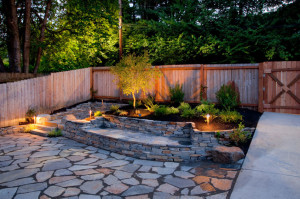‘Tis’ the season’: why the winter months are a great time for landscaping design
 Are you thinking it’s time to ‘spruce’ up your property with new landscaping?
Are you thinking it’s time to ‘spruce’ up your property with new landscaping?
The winter months are the perfect time of year to consider how new landscaping design could transform your space, improve the curb appeal of your property, and provide new opportunities for growth and change to better develop your garden, yard, storefront, or office park. How? Well, we’re not necessarily talking about adding new plants or ‘green-scape.’
Instead, now is the time to consider how your landscaping design can better incorporate hardscaping elements. With most plants dormant and the ground frozen, the winter months really put the focus on hardscape elements in your landscaping design, such as walkways, use of lighting, art and open space areas.
Additionally, the winter months are a perfect opportunity to have a design expert review and draft a new layout, assess your use of plants, and discuss adding hardscape elements that will improve the overall design, aesthetics, and functionality of your living (or working) space.
But first, let’s define our terms.
Did you know that landscaping design includes more than just greenery? Most people think of flower beds, grass, shrubs, and trees when they think about landscaping options. But a good engineering team will tell you that it’s often the hardscape elements that can make all of the difference.
What are common hardscape elements in landscaping design?
- Pedestrian paths and walkways
- Driveways and paved parking
- Decorative stonework, such as terracing
- Art elements, such as birdbaths and sculptures
- Fencing and privacy walls
- Retaining walls and water features
- Lighting elements
- Porches, patios, stairways, and benches
You get the idea. Hardscaping includes virtually all of the non-plant elements that give the shape, structure and design to your landscape. And a good landscaping design person will help you choose the right materials, such as brick or stone, to work within the natural environment of your space.
Moreover, the benefits of hardscape elements in landscaping design include increased curb appeal, better use of and utility in your space, improved water use and overall savings, and (with good design) total reduced maintenance costs.
For example, better hardscaping elements can create a walkway and/or seating area that make it more likely that you’ll be able to enjoy your landscaping during both the winter and warmer spring, summer and fall months, and make it easier to get around your property all year long.
Hardscaping also allows designers to create something beautiful while reducing the need for plants, and therefore reducing water and maintenance costs. A good landscaping expert will also have the engineering ability to move water features and create drainage systems, which are critical to prevent damage to the buildings on the property, and prevent slip-and-fall accidents.
So, how do you get started to review your landscape design elements, and add beautiful and beneficial hardscaping? As a first step we recommend that you have a landscaping design consultant out to vist your property and put together a plan, based on your goals.
An expert can provide you with cost estimating and budgeting for your project; site and master plan design; irrigation, plaza and paving design; permitting and city approvals; and construction administration.
And we’re not just talking about new construction. All of the above include remodeling plans, with illustrative and graphic renderings to help be sure you’re ‘on the same page’ with your landscaping expert, before moving forward.
Ready to move forward with improved landscaping design plans, or just want to see what we can do for you?
Please get in touch with the team at McNeil Engineering to learn more, and visit our website to see a portfolio of our work. With more than 35 years of experience, and a portfolio that includes work on public, private, large and small scale projects in communities throughout the west, we have the team that you need to complete your project.

